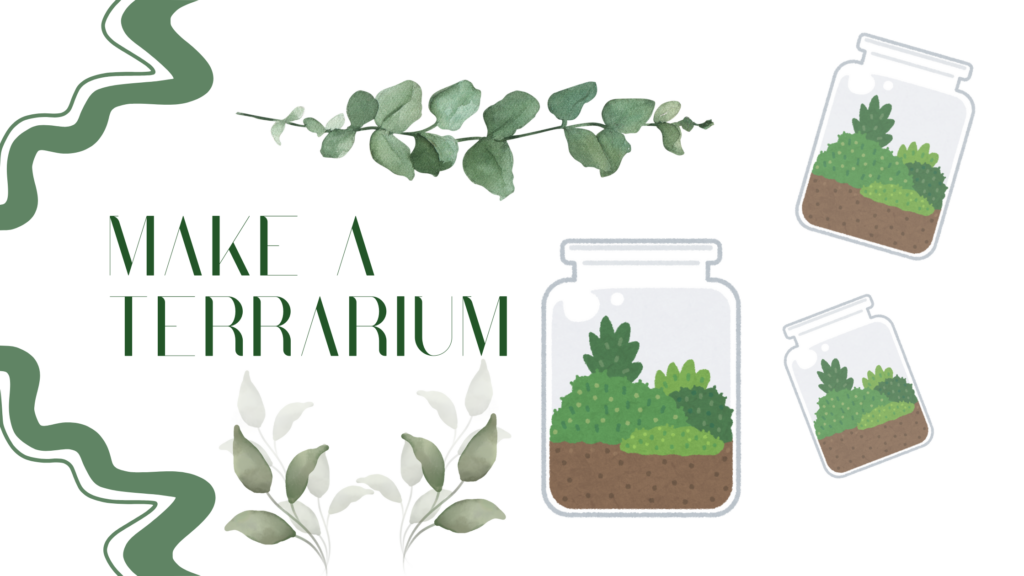
Terrariums are self-sustaining ecosystems that are easy to make and educational for children. They work by using photosynthesis and the water cycle to keep everything inside the terrarium alive and are a good reminder of how nature works on its own.
Terrariums can be made to act as mini wetlands which is why they are a good activity to do on World Wetlands Day on 2nd February.
What is a terrarium?
A terrarium is a closed self-sustaining ecosystem that can mimic a wetland ecosystem. It’s filled with small plants that can stand humidity as well as rocks and small ornaments that make them visually appealing.
Terrariums rely on the water cycle to keep them alive. The water that exists in the terrarium goes into the soil for the plants to drink. Water evaporates through the plants’ leaves and creates condensation on the terrarium glass which is reabsorbed by the soil for the water cycle to start again.
What is a wetland?
A wetland is defined as an area or ecosystem where water is the controlling factor for sustaining life. The word ‘wetland’ can also be used to describe areas of land which are seasonally flooded with water.
Some examples of wetlands include marshes, mangroves, swamps, ponds, floodplains, rice paddies and even coral reefs.
Why are wetlands important?
Wetlands are some of the most important ecosystems in the world. They cover 6% of the earth’s land mass and 40% of the world’s flora and fauna call them home, or visit to breed.
Not only are they important for all of this wildlife but they’re also important for us as humans too. They are key for climate change as they capture carbon (twice as much as all the forest in the world*), work as natural flood defense systems and store water to release slowly during droughts.
What is happening to the world’s wetlands?
Sadly, the world’s wetlands are in danger. Due to climate change and overpopulation, their numbers are rapidly declining. Between 1970 – 2020, 35% of the world’s wetlands were destroyed**.
It means that the biodiversity in these wetlands is at risk and our climate is less stable.
What can we do to protect wetlands?
World Wetlands Day on 2nd February raises awareness for wetlands. The key is to restore, conserve and prevent the future destruction of our remaining wetlands.
But how can we do this?
From home, you can follow simple steps like only using water when you need it. The less water you use, the more water stays in our wetlands for wildlife. You can also make sure that you dispose of your litter responsibly so it doesn’t end up in the natural environment.
Make your own terrarium
Difficulty: medium
Age rating: 5+
Time: 30 minutes
You will need:
- A large, clean glass jar with a lid
- Small pebbles or shingle
- Charcoal, optional
- Moss
- Moist soil
- Small rocks
- Small plants that are good with humidity and don’t need direct sunlight
- Tweezers
- A paint brush to clean
How to make your own terrarium
- Make your drainage layer: Cover the bottom of your terrarium with around 1 cm of small pebbles or shingle.
- Add a handful of moss or charcoal to cover the bottom layer
- Add a layer of moist soil that’s three times the size of your drainage layer
- Create your scene: Add a layer of bright moss on top of the soil and add your small plants into the soil. Then, surround them with pebbles, and ornaments. You may need your tweezers to move everything around.
- Use a paint brush to clean the sides of the terrarium
- Put the lid on your terrarium and display it in a well-lit room out of direct sunlight
Tips to look after your terrarium
- Keep it out of direct sunlight
- If the terrarium or your plants look too wet, open the lid for a day or until conditions improve and then close it again
- If your terrarium looks too dry, spritz it with water
Give this a go and share your photos with us on instagram @notboredbox
